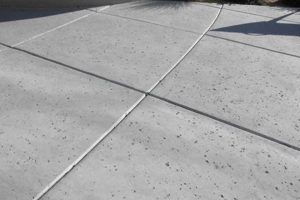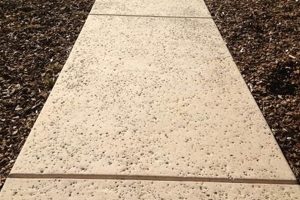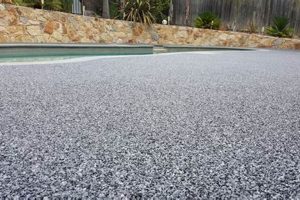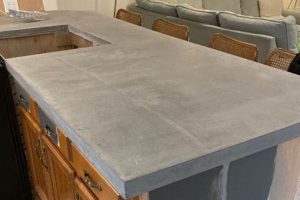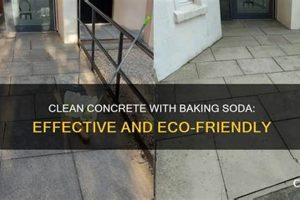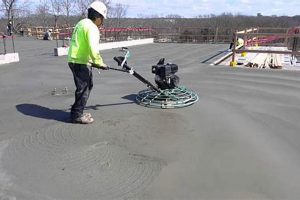A surface treatment process, typically applied to hardened slabs, results in a subtly textured and visually appealing outcome. This technique employs a mild chemical solution to etch away the top layer of cement paste, revealing the aggregate beneath. The resulting effect is a non-slip surface that also presents an aesthetic alternative to smoother finishes. An example includes walkways and patios where both safety and visual appeal are desired.
This method offers multiple advantages, including enhanced traction, improved durability, and a unique decorative aspect. Its ability to expose the natural aggregate provides a cost-effective way to achieve a high-end look. Historically, this surface treatment has been utilized in both residential and commercial settings for its practical benefits and visual versatility, increasing the longevity of heavily trafficked areas.
The selection of appropriate application techniques and safety precautions are critical considerations when implementing this process. The following sections will provide a more detailed examination of application, safety considerations, and design options related to this surfacing method.
Essential Considerations for Achieving Optimal Results
Success in surface modification requires attention to detail and adherence to best practices. The following points outline key considerations for ensuring a durable and aesthetically pleasing outcome.
Tip 1: Precise Mixture Calibration: The proportion of chemical solution to water must be carefully measured. Deviation from recommended ratios can lead to either insufficient etching or excessive surface damage.
Tip 2: Uniform Application: Apply the solution evenly across the entire surface. Uneven application results in inconsistent texture and visual irregularities. Utilize a consistent spraying pattern or application method.
Tip 3: Controlled Exposure Time: Monitor the duration the solution remains on the surface. Overexposure leads to excessive aggregate exposure and potential weakening of the slab’s structure. A shorter exposure may result in an underdeveloped effect.
Tip 4: Thorough Neutralization: After the desired surface is achieved, completely neutralize the chemical residue with an appropriate neutralizing agent. Inadequate neutralization can cause ongoing etching and surface degradation.
Tip 5: Immediate and Complete Rinse: After neutralization, thoroughly rinse the treated area with copious amounts of water to remove all remaining chemical compounds. Residue can affect the color and longevity of any applied sealers.
Tip 6: Adequate Surface Preparation: Before beginning the treatment, ensure the surface is clean, free of debris, and structurally sound. Existing cracks or contaminants may be exacerbated by the process.
Tip 7: Temperature Considerations: Avoid performing the treatment in extreme temperatures. High temperatures accelerate the chemical reaction, potentially leading to uneven etching. Low temperatures may inhibit the reaction entirely.
Implementing these considerations is crucial for achieving a successful, durable, and visually appealing result. Proper execution not only enhances the aesthetic quality but also extends the lifespan of the treated surface.
The following section will address common challenges encountered during this process and provide potential solutions for mitigating such issues.
1. Surface Preparation
Effective implementation of surface treatment is fundamentally linked to the quality of preparatory work. The condition of the substrate directly influences the uniformity and durability of the outcome. Contaminants, existing coatings, or structural weaknesses impede chemical interaction and compromise adhesion. For instance, oil stains prevent the solution from uniformly etching the surface, resulting in uneven texture and discoloration. Failure to address pre-existing cracks can lead to their exacerbation during the etching process, necessitating costly repairs. Therefore, meticulous cleaning, repair, and profiling are essential to creating a receptive surface.
Practical applications demonstrate the tangible benefits of thorough surface preparation. In industrial settings, where floors are often subjected to heavy use and chemical exposure, proper cleaning and degreasing before treatment significantly enhance the longevity of the protective layer. Similarly, in residential patios, removing algae and moss ensures even etching, preventing patchy discoloration. Grinding or shot-blasting may be necessary to remove stubborn coatings or create a consistent surface profile, thereby optimizing the solution’s effectiveness.
In summary, neglecting adequate surface preparation is a primary cause of premature failure. The initial investment in proper cleaning, repair, and profiling yields substantial returns in terms of increased durability, aesthetic quality, and reduced maintenance costs. This foundational step is critical for achieving the desired effect and ensuring the long-term performance of treated surfaces.
2. Chemical Solution
The chemical solution is the active agent that facilitates the transformative process resulting in a distinct surface. Its composition and application directly determine the texture, aesthetic, and performance characteristics of the treated material. Understanding the nuances of the solution is therefore paramount to achieving desired outcomes.
- Acid Type and Concentration
The selection of acid (typically hydrochloric or phosphoric) and its concentration dictates the aggressiveness of the etching process. Higher concentrations yield a more pronounced aggregate exposure, while lower concentrations produce a subtle, refined surface. Hydrochloric acid, being more aggressive, is often used for exterior applications where a deeper etch is desired. Phosphoric acid, with its milder action, is frequently employed for interior surfaces to minimize damage and control the level of texture.
- Reaction Rate and Temperature Sensitivity
The chemical reaction between the solution and the cement paste is influenced by temperature. Elevated temperatures accelerate the etching process, potentially leading to uneven or excessive material removal. Conversely, low temperatures can inhibit the reaction, requiring longer exposure times or higher concentrations. Maintaining a consistent temperature range is crucial for uniform results, often necessitating application during moderate weather conditions or within controlled environments.
- Neutralization and Residue Management
Following the etching process, thorough neutralization is essential to halt the chemical reaction and prevent ongoing surface degradation. Alkaline solutions, such as sodium bicarbonate, are commonly used to neutralize the acidity. Inadequate neutralization can result in efflorescence, discoloration, or weakening of the surface. Furthermore, complete removal of residual chemicals is vital to ensure proper bonding of subsequent sealers or coatings.
- Safety and Environmental Considerations
The handling and disposal of these chemical solutions necessitate strict adherence to safety protocols. Personal protective equipment, including gloves, eye protection, and respirators, is mandatory to prevent skin irritation, respiratory damage, or eye injury. Environmentally responsible disposal methods are crucial to minimize the impact on ecosystems and comply with local regulations. Improper disposal can lead to soil and water contamination, posing significant environmental hazards.
In summary, the effective utilization of chemical solutions in achieving surface treatment requires careful consideration of acid type, concentration, temperature sensitivity, neutralization processes, and safety precautions. The interplay of these factors directly influences the aesthetic and performance characteristics, underscoring the importance of informed decision-making and rigorous adherence to best practices.
3. Application Technique
The method by which the chemical solution is introduced to the hardened surface is a critical determinant of the final aesthetic and performance characteristics. Variations in technique directly influence the uniformity and depth of the etch, impacting aggregate exposure and surface texture. An inconsistent application can result in an uneven finish, characterized by areas of over-etching where the aggregate is excessively exposed, juxtaposed with areas of under-etching where the cement paste remains largely intact. This inconsistency not only detracts from the visual appeal but can also compromise the slip resistance of the surface. Real-world examples include unevenly etched patios that exhibit patchy discoloration and varying degrees of roughness, or industrial floors where inconsistent etching leads to localized areas of weakness and accelerated wear. This understanding is practically significant, as it underscores the necessity of employing skilled applicators and adhering to established protocols to ensure consistent and predictable results.
Consider the comparative effects of spray application versus brush application. Spraying, when performed correctly, offers the advantage of uniform distribution over large areas, minimizing the risk of overlap and inconsistent coverage. However, spray application requires careful attention to nozzle selection, spray pressure, and operator technique to prevent overspray and wind drift. Brush application, while suitable for smaller, intricate areas, demands a high degree of manual dexterity and consistency to avoid brush marks and uneven saturation. Examples can be seen in decorative concrete projects, where stencils or intricate patterns require precise brushwork to achieve sharp lines and well-defined designs. In contrast, large, open areas benefit from the efficiency and uniformity of spray application, provided that appropriate precautions are taken to mitigate environmental concerns and ensure even coverage.
In conclusion, the chosen application technique is inextricably linked to the success of the surface treatment. Whether utilizing sprayers, brushes, or other specialized equipment, meticulous attention to detail and adherence to best practices are paramount. The challenges associated with inconsistent application can be mitigated through proper training, equipment calibration, and rigorous quality control measures. The practical significance of this understanding lies in the ability to achieve consistently high-quality results, enhancing the aesthetic appeal, durability, and safety of concrete surfaces.
4. Neutralization Process
The neutralization process represents a critical and indispensable step within the application of an surface treatment. Following the chemical etching, residual acids remain on the surface, continuing to react with the cement matrix. This ongoing reaction, if unchecked, leads to uncontrolled degradation, compromising the structural integrity and aesthetic characteristics. The neutralization process effectively halts this etching action by applying an alkaline solution, typically sodium bicarbonate or a similar base, to counteract the remaining acidity. Failure to neutralize completely results in efflorescence, discoloration, and a weakened surface susceptible to accelerated wear. A practical example includes outdoor installations, where incomplete neutralization exacerbates the effects of freeze-thaw cycles, leading to premature cracking and surface spalling. This understanding underscores the vital role of neutralization in preserving the durability and appearance of the finished product.
The effectiveness of the neutralization process is directly linked to the type and concentration of the neutralizing agent, the thoroughness of its application, and the duration of contact with the treated surface. Insufficient concentration or incomplete coverage allows residual acid to persist, continuing the etching action. Inadequate contact time prevents the neutralizing agent from fully reacting with the acid, leaving active compounds on the surface. Practical application necessitates careful monitoring of pH levels to ensure complete neutralization, often involving multiple applications of the neutralizing agent followed by rigorous rinsing. For instance, in large-scale industrial flooring projects, automated scrubbing systems with pH monitoring capabilities are employed to ensure thorough neutralization across the entire surface.
In summary, the neutralization process is not merely a supplementary step but an integral component in achieving a durable and aesthetically pleasing surface. Its absence or inadequate execution compromises the long-term performance and visual appeal. The challenges associated with incomplete neutralization can be mitigated through strict adherence to recommended procedures, careful monitoring of pH levels, and the implementation of quality control measures. The practical significance of this understanding lies in the ability to safeguard the investment in surfacing, ensuring its longevity and resistance to environmental degradation.
5. Sealing Application
The application of a sealant is a critical post-treatment process, directly influencing the durability, aesthetic retention, and overall performance of a surfaced slab. Proper sealing mitigates the inherent porosity, protects against environmental factors, and enhances the visual characteristics.
- Protection Against Staining and Chemical Intrusion
Sealers create a barrier that prevents liquids and chemicals from penetrating the exposed aggregate and cement matrix. This protection is crucial in environments where surfaces are susceptible to spills of oil, grease, acids, or other staining agents. For instance, in garages or industrial settings, sealed surfaces resist the absorption of automotive fluids, simplifying cleaning and preventing permanent discoloration. Without sealing, these substances readily penetrate, leading to unsightly stains and potential material degradation.
- Enhancement of Durability and Resistance to Abrasion
Sealers fortify the treated surface, increasing its resistance to abrasion and wear. This is particularly important in high-traffic areas where constant foot or vehicular traffic can gradually erode the exposed aggregate and cement. A sealed surface experiences reduced wear, extending its lifespan and minimizing the need for costly repairs or replacements. Consider the impact on a commercial walkway: sealing significantly reduces the erosion caused by pedestrian traffic, maintaining its aesthetic appeal and structural integrity over time.
- Improvement of Aesthetic Appearance and Color Retention
Many sealers enhance the natural colors of the aggregate and provide a glossy or matte finish that enhances the overall visual appeal. Some sealers are specifically formulated to intensify the colors and provide a wet look, while others offer a more subtle, natural appearance. By preventing the absorption of moisture and UV radiation, sealers also help to maintain the color integrity of the surface, preventing fading and discoloration. This is especially evident in outdoor applications where unsealed surfaces are prone to fading and weathering.
- Prevention of Freeze-Thaw Damage
In climates where temperatures fluctuate below freezing, the penetration of water into the porous structure can lead to freeze-thaw damage. As water freezes, it expands, exerting pressure on the surrounding material and causing cracks and spalling. Sealers prevent water from entering the pores, significantly reducing the risk of freeze-thaw damage and extending the lifespan of the treated slab. This protection is crucial in regions with harsh winter conditions, where unsealed surfaces are highly susceptible to deterioration.
The selection of an appropriate sealer is critical and depends on the specific application, environmental conditions, and desired aesthetic. Considerations include the type of sealer (acrylic, epoxy, polyurethane), its permeability, UV resistance, and slip resistance. Proper surface preparation and application techniques are essential for achieving optimal adhesion and performance, ensuring the longevity and visual appeal of the surfaced area.
Frequently Asked Questions About Acid Finish Concrete
This section addresses common inquiries regarding the nature, application, and maintenance of surfaces prepared using a chemical etching process.
Question 1: What is the primary purpose of using a chemical treatment?
The primary purpose is to alter the surface texture, typically to increase slip resistance and expose the aggregate. This process enhances both safety and aesthetic appeal.
Question 2: Is it safe to use this chemical process around landscaping and vegetation?
Precautions are necessary to protect surrounding vegetation. Covering plants and ensuring proper runoff management can minimize potential damage from chemical exposure.
Question 3: How long does it last?
The longevity of a chemically treated surface depends on factors such as traffic volume, environmental conditions, and maintenance practices. Regular cleaning and sealing can significantly extend its lifespan.
Question 4: Can the treatment be applied to existing slabs?
Yes, the treatment can be applied to existing slabs, provided they are structurally sound and properly prepared. Existing coatings or contaminants must be removed before application.
Question 5: What maintenance is required after the treatment?
Routine cleaning with a mild detergent is generally sufficient. Periodic resealing may be necessary to maintain the protective barrier and enhance aesthetic qualities.
Question 6: Does this treatment affect the structural integrity?
When performed correctly, the treatment does not significantly affect the structural integrity. It removes a minimal layer of cement paste, primarily impacting the surface texture.
Understanding these key aspects facilitates informed decisions regarding the implementation and care of chemically treated surfaces, ensuring optimal performance and longevity.
The following section will explore specific design considerations and aesthetic possibilities achievable through this process.
Concluding Remarks on Acid Finish Concrete
This exposition has presented a comprehensive overview of acid finish concrete, encompassing its definition, application techniques, safety protocols, and long-term maintenance considerations. The process, when executed with precision and adherence to best practices, yields a durable, aesthetically pleasing surface suitable for a wide range of applications. Surface preparation, chemical solution management, application consistency, neutralization efficacy, and sealing implementation were highlighted as critical factors influencing the final outcome.
The responsible and informed application of acid finish concrete requires diligent attention to detail and a commitment to safety. As a proven method for enhancing both the functionality and visual appeal of concrete surfaces, continued research and refinement of application techniques will undoubtedly further expand its utility across diverse architectural and engineering endeavors. Prudent implementation ensures longevity, safety, and aesthetic success.


